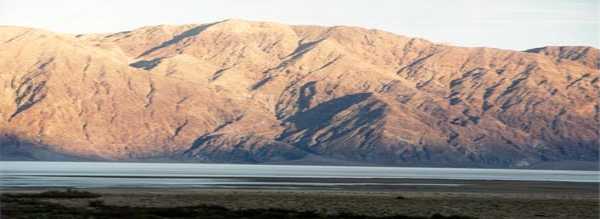

Despite the name, the dramatic history of human suffering and its reputation for searing heat, Death Valley is actually one of the most hauntingly beautiful places on earth. Carved by geologic forces so complex and weird that they are only dimly understood, the floor of the valley is sinking today and is over 200 feet below sea level. Geologists like Dr. Paul Knauth, our leader on this ASU outreach trip, are forced to use analogies as tortured as the terrain. Paul's favorite analogy envisages a layer cake resting on a pallet of wet fish which is slowly being lifted from below. As the fish slide and slither underneath, the cake breaks up and portions slip into the gaps between fish.
In summer Death Valley is inhabited, not by mad dogs and Englishmen, but by German and Scandinavian tourists (it's a sort of "been there, done that" thing). In the winter, though, it's a very pleasant place with night time temperatures dropping to near freezing and highs in the upper 60's F.
|
|
Thursday 1-14-99. We flew from Phoenix to Las Vegas to meet Dr. Paul Knauth, Todd Luther (his grad assistant) and Darla Ekbom (organizer, food service operative and slave). |
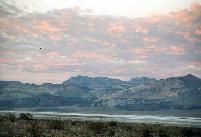
Death Valley from the East |
We drove over Spring Mountain pass, along the line of the Old Spanish Trail and through Immigrant Pass. In the Resting Springs Range, Paul showed us the last regular beds (strata) before we crested the last range and plunged into the geological blender that is Death Valley. We stopped at Ashford Mill ruins, the site of an old gold mine and walked out on the salt pan at Badwater before arriving at Furnace Creek ranch, our home for the duration. |

Date palms, first light, Furnace Creek |
Furnace Creek Ranch is comfortable and idyllically situated on a hot spring. The rooms are large motel rooms or cabins (we stayed in a motel section). It is cold at night at this time of year. The food is reasonably good but overpriced, the usual National Park Lodge fare. There is a date plantation, an excellent ad-hoc mining museum, a gift shop, post office and a swimming pool fed from the hot springs. The water temp in the pool is about 84 degrees year-round. |

Death Valley floor |
The Visitor Center is a short walk from the Ranch, and has excellent
books and maps on Death Valley geology and
history.
Friday 1-15. We stopped to look at an old beach, the former shore of Lake Manly which once filled Death Valley. Next, we drove to Monarch Canyon which is accessed via a difficult dirt road (high clearance essential). This is a beautiful, gnarly old canyon system with interesting walks and excellent views. Ron spotted a bighorn sheep watching us from high above. |
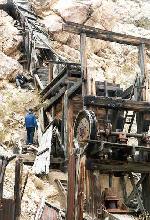
Indian Mine. Old chute and stamp mill. |
 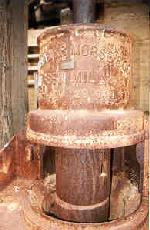
Detail of the stamp mill pulley and stamp at Indian Mine, Monarch Canyon |
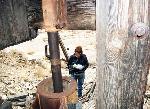
Wendy examines the stamp mill |
Also in Monarch Canyon is Indian Mine, a wonderful old gold mine. The mine shaft and chute and the old stamp mill that was used to crush the gold bearing quartz are all still intact. You can scrabble about for hours searching the tailings for traces of gold. |

En route to Tule Spring |
Finally today we drove down to Tule Spring on the west side of the valley and wandered around over a huge alluvial fan looking at old Indian remains. We found a burial site complete with an old (possibly human) rib, several stone circles and some pictographs. The alluvial fans on the west side are textbook classics - in fact I remember seeing one years ago in my old geography text book back in high school in Canterbury, England. |

Pictograph at Tule Spring |
On the east side of the valley there are many faults and the valley
is slumping down towards the east, so here the fans are truncated and scarred
and not so classic, but still just as interesting. On Saturday 1-16,
we went to another Indian site where we saw an ancient mousetrap and more
circles. One circle (probably an old store for mesquite pods, the staple
diet) was intact below a fault. This showed that the fault shifted before
the Indians built the store, otherwise it would have been disrupted. Unfortunately,
neither the fault nor the habitation can be dated.
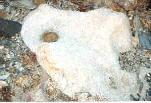 Indian mortar, used for grinding pods.
Indian mortar, used for grinding pods. |
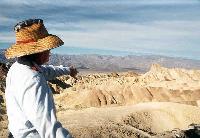
Paul geologises at Zabriskie Point |
Next, we drove to the overlook at Zabriskie Point, surely one of the
strangest places on earth. This is old lake sediment which has been riven
with lava, carved and cut by wind, rain and quake. The whole turgid history
of the place is laid before us, and Paul makes the most of it. He is a
wonderful teacher with the ability to summon up colorful turns of phrase
on a whim. I really must write some of them down.
From Zabriskie we hiked down through the Badlands and into Golden Canyon, a gentle hike of about two hours |

Hiking the Badlands |
This is a great hike. The trail winds from ridge to ridge, past old
mine shafts and under the foot of Manly Point. Everywhere there are tortured
vistas of rock and sky. No wonder Antonioni chose this area for his film
"Zabriskie Point" in the sixties.
At the mouth of the canyon, Darla awaited us with the usual beautifully presented lunch of cold meats, cheeses and everything the hungry hiker could wish for. We descended upon it like a pack of vultures from the Badlands. |
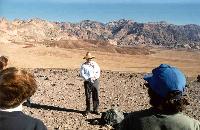
Paul shows us a ventifact |
After lunch we hiked from a road in the valley floor to the top of a mound of stranded alluvial deposit. At the top the rocks have been carved by the sand into triangular shapes called ventifacts. Loose sand blows against the face of the rocks and carves them into triangular shapes with knife edges. These are useful markers, for when they are found in deposits it indicates that they were once exposed under conditions like these. |

Ed at the Canyon-with-no-name. |
 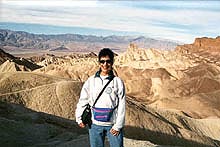
Darla as the "Black Angel of Death Valley" and Barbara at Zabriskie Point |

The sand dunes. |
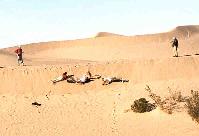 |
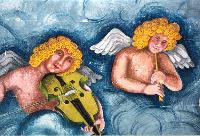
Detail of Amargosa Opera House ceiling. |
On Saturday evening we attended a performance at the Amargosa Opera House. Marta Becket is an American legend. Deferential articles about her were to be found at the Smithsonian site and at a German travel site but were recently removed. In any case, Marta probably disdains computers for she writes in the program for The Dollmaker "We must take caution to not become enamored with mechanical devices of convenience lest we become mechanical ourselves. Or worse, overtaken by mechanical progress it'self." |
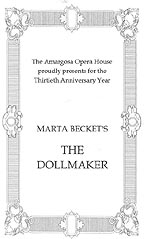 |
With her ungainly sidekick, Wilget, Marta leads us through one of her
quirky blends of ballet, vaudeville, mime and puppetry (of a sort). Her
"plots" are embarrassingly naive, her singing marginal, and Wilget's bumbling
comic style adds a touch of hysteria to the proceedings. The audience is
mostly struck dumb throughout. That Marta was once a fine dancer is apparent
even now as, well into her seventies, she still manages to totter about
on points.
Thankfully, the end comes soon and the packed house erupts in applause. Paul approaches the stage with a bouquet of flowers for the grand dame, with whom he is hopelessly besotted. Another evening of baroque entertainment in the rickety Opera House in the desert is over and the bemused patrons stumble out into the cold night air. Marta may have stumbled upon Death Valley Junction by accident but the symbiosis is obvious - only in this wildly jumbled chaos of rocks could this complicated artist bloom and flourish. |
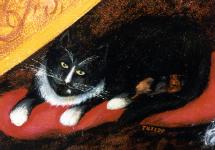
Cats on Theater walls |
Of all Marta's multi-faceted talents, I like her work as a painter best. Her minimalist set designs, while as eccentric as the rest of the performance, are truly inspired. Some of her murals which decorate the entire interior of the Amargosa Opera House sparkle with life and showmanship. Her Mexican paintings in the adjacent hotel are full of primitive pathos and sensuality. |
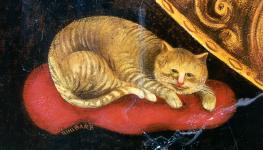 |
 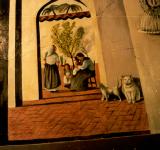
Hotel interior and murals |
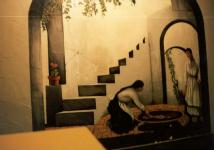 |
|
| On the last day of the trip we drove to the overlook at Dante's view for a spectacular last look at the valley floor and the Sierras peeking over the Panamint range to the west. A beckoning promise of a trip yet to come? We hope so. |
 |
